
The Waffen-SS was the combat branch of the Nazi Party's paramilitary Schutzstaffel (SS) organisation. Its formations included men from Nazi Germany, along with volunteers and conscripts from both occupied and unoccupied lands.
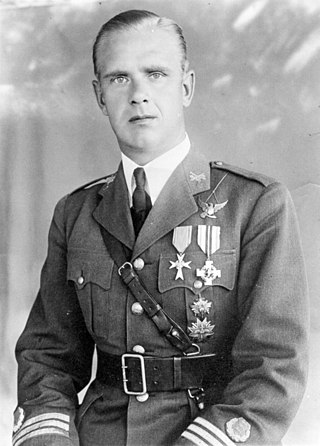
Alfons Vilhelm Robert Rebane, known simply as Alfons Rebane was an Estonian military commander. He was the most highly decorated Estonian military officer during World War II, serving in various Wehrmacht and Waffen-SS units of Nazi Germany.
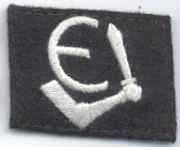
The 20th Waffen Grenadier Division of the SS was a foreign infantry division of the Waffen-SS that served alongside but was never formally part of the Wehrmacht during World War II. According to some sources, the division was under Reichsführer-SS Heinrich Himmler's overall command but was not an integral part of the Schutzstaffel (SS). It was officially activated on 24 January 1944, and many of its soldiers had been members of the Estonian Legion and/or the 3rd Estonian SS Volunteer Brigade, which had been fighting as part of German forces since August 1942 and October 1943 respectively. Both of the preceding formations drew their personnel from German-occupied Estonia. Shortly after its official activation, widespread conscription within Estonia was announced by the German occupying authorities. The division was formed in Estonia around a cadre comprising the 3rd Estonian SS Volunteer Brigade, and was initially known as the 20th Estonian SS Volunteer Division.

During World War II, in the course of Operation Barbarossa, Nazi Germany invaded Estonia in July–December 1941, and occupied the country until 1944. Estonia had gained independence in 1918 from the then warring German and Russian Empires. However, in the wake of the August 1939 Nazi-Soviet Pact, the Stalinist Soviet Union had invaded and occupied Estonia in June 1940, and the country was formally annexed into the USSR in August 1940.

The military occupation of Latvia by Nazi Germany was completed on July 10, 1941 by Germany's armed forces. Initially, the territory of Latvia was under the military administration of Army Group North, but on 25 July 1941, Latvia was incorporated as Generalbezirk Lettland, subordinated to Reichskommissariat Ostland, an administrative subdivision of Nazi Germany. Anyone not racially acceptable or who opposed the German occupation, as well as those who had cooperated with the Soviet Union, were killed or sent to concentration camps in accordance with the Nazi Generalplan Ost.

The Latvian Legion was a formation of the German Waffen-SS during World War II. Created in 1943, it consisted primarily of ethnic Latvian personnel. The legion consisted of two divisions of the Waffen-SS: the 15th Waffen Grenadier Division of the SS, and the 19th Waffen Grenadier Division of the SS. The 15th Division was administratively subordinated to the VI SS Corps, but operationally it was in reserve or at the disposal of the XXXXIII Army Corps, 16th Army, Army Group North. The 19th Division held out in the Courland Pocket until May 1945, the close of World War II, when it was among the last of Nazi Germany's forces to surrender.
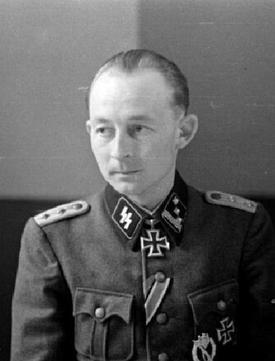
Paul Maitla was an Estonian commander in the German Waffen-SS during World War II. He is one of the four Estonians who received the Knight's Cross of the Iron Cross of Nazi Germany. He received his award for leading the recapture of the central hill of the Sinimäed during the Battle of Tannenberg Line, effectively breaking the Soviet offensive in that sector.

Estonia–Russia relations are the bilateral foreign relations between Estonia and Russia. Diplomatic relations between the Republic of Estonia and the Russian SFSR were established on 2 February 1920, when Soviet Russia recognized de jure the independence of the Republic of Estonia, and renounced in perpetuity all rights to the territory of Estonia, via the Treaty of Tartu (Russian–Estonian). At the time, the Bolsheviks had just gained control of the majority of Russian territory, and their government's legitimacy was being hotly contested by Western powers and the Russian White movement.

Remembrance Day of the Latvian Legionnaires, often known simply as the Legionnaire Day or March 16 in Latvia, is a day when soldiers of the Latvian Legion, part of the Waffen-SS, are commemorated. From 1998 until 2000, it was officially recognized as a "Remembrance Day for Latvian soldiers" by the Saeima.

After the German invasion of the Soviet Union, the Baltic states were under military occupation by Nazi Germany from 1941 to 1944. Initially, many Estonians, Latvians, and Lithuanians considered the Germans liberators from the Soviet Union.
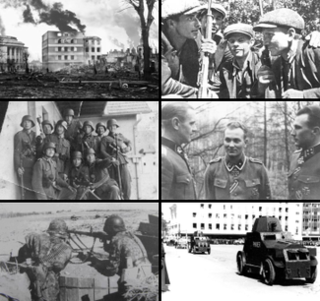
Estonia declared neutrality at the outbreak of World War II (1939–1945), but the country was repeatedly contested, invaded and occupied, first by the Stalinist Soviet Union in 1940, then by Nazi Germany in 1941, and ultimately reinvaded and reoccupied in 1944 by the Soviet Union.

The Bronze Night, also known as the April Unrest and April Events, refers to the riots in Estonia surrounding the controversial 2007 relocation of the Bronze Soldier of Tallinn, a Soviet World War II memorial in Tallinn.
Aftermath of the Bronze Night refers to the reactions and consequences of the Bronze Night, the controversy and riots in Estonia surrounding the 2007 relocation of the Bronze Soldier of Tallinn, the Soviet World War II memorial in Tallinn.
Gerhard Sommer was a German SS-Untersturmführer in the 16th SS Panzergrenadier Division Reichsführer-SS who was involved in the massacre of 560 civilians on 12 August 1944 in the Italian village of Sant'Anna di Stazzema. He appeared on the Simon Wiesenthal Center's list of most wanted Nazi war criminals.

During World War II, the Waffen-SS recruited significant numbers of non-Germans, both as volunteers and conscripts. In total some 500,000 non-Germans and ethnic Germans from outside Germany, mostly from German-occupied Europe, were recruited between 1940 and 1945. The units were under the control of the SS Führungshauptamt beneath Reichsführer-SS Heinrich Himmler. Upon mobilization, the units' tactical control was given to the Oberkommando der Wehrmacht.

The guerrilla war in the Baltic states was an insurgency waged by Baltic partisans against the Soviet Union from 1944 to 1956. Known alternatively as the "Forest Brothers", the "Brothers of the Wood" and the "Forest Friars", these partisans fought against invading Soviet forces during their occupation of the Baltic states during and after World War II. Similar insurgent groups resisted Soviet occupations in Bulgaria, Poland, Romania and Ukraine.

The Monument to the Defenders of Bauska was unveiled in the small town of Bauska in southern Latvia on 14 September 2012.

The Conservative People's Party of Estonia is a nationalist and right-wing populist political party in Estonia, currently led by Martin Helme. It was founded in March 2012, with the merger of People's Union of Estonia and Estonian Patriotic Movement. Its first leader, Margo Miljand, served as the chairman until 2013 when he was succeeded by Mart Helme. Its popularity remained low until late 2014, when the party began to draw supporters from the right; further, in the 2015 Estonian parliamentary election, it passed the electoral threshold and won seats in parliament for the first time. Since then its support has grown, turning it into one of the largest parties in Estonia. In the 2019 Estonian parliamentary election, EKRE placed third, winning 19 seats in total. Mart was succeeded as party chairman by his son, Martin Helme, in July 2020.
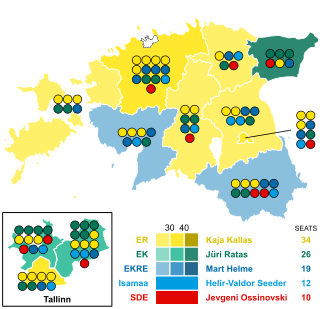
Parliamentary elections were held in Estonia on 3 March 2019. The newly elected 101 members of the 14th Riigikogu assembled at Toompea Castle in Tallinn within ten days of the election. The Reform Party remained the largest party, gaining four seats for a total of 34 and the Conservative People's Party had the largest gain overall, increasing their seat count by 12 to a total of 19 seats.
Canada has several monuments and memorials that to varying degrees commemorate people and groups accused of collaboration with Nazi forces.

















